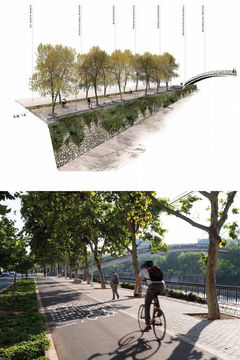2018 Americas Prize

MAPOCHO 42K
M42K Lab, Sandra Iturriaga
Santiago, Chile
January 2017
PRIMARY AUTHOR
Sandra Iturriaga
CONTRIBUTING AUTHOR
Juan Baixas (architect) Juana Zunino (landscape architect) Paulina Ibieta (architect) Francisco Croxatto (architect) Paula Mulatti (architect ) Francisco Quintana (architect coordinator) Andrés Salazar (architect (c) collaborator) Enzo Morales (designer collaborator) Felipe de la Vega (architect Serviu)
CLIENT
Escuela de Arquitectura Universidad Católica de Chile
PHOTOGRAPHER
Francisco Croxatto Cristóbal Correa
OBJECTIVE
A Geographical Promenade as social equity: The Project proposes to recover the Mapocho riverbank´s as an east-west oriented backbone of Santiago de Chile, a geographical Promenade that crosses 42 km on its course through the city, starting from the Andes mountain range until the beginning of the rural area. This riparian Promenade is proposed as a public space meant for pedestrians and cyclist alike, either strolling, sporting or commuting, which allows to connect eleven communes of different social and topographic strata, stimulating their integration within a highly segregated city, and contributing to improve their quality of urban life and social equity. At the same time, this Promenade is proposed as a green corridor that seeks to connect all existing parks and potential green areas along the river's edge, making possible to relate them to other parks or nearby hills as part of the same matrix of green spaces. This allows to reveal the landscape of the valley of Santiago through an element of geographical continuity, as well as a social connection devise. Mapocho 42K is proposed therefore as a geographical, environmental and social Promenade, capable of reconfiguring the lost connectivity as an attribute of urban equity.
CONTEXT
A Collective Project to the River: The Mapocho 42K proposal was born as an academic experience developed in 2011 as an applied research, and since the year 2014 became a concrete proposal for the city. From that moment, onwards, the project has been designed and implemented in stages, allowing today to connect seven riparian communes. Given the multiplicity of situations, and actors inherent to the riparian area, one of the main challenge was to expand the architect’s role as “assembler-designer”, in order to uphold its condition as a Collective Project. The design strategy was to work with an “open” matrix, that is based on a set of components, that allows the establishment of a unitary character and identity along the complete 42K promenade, but at the same time, capable to incorporating new variables throughout the development of the project. Two urban situations have been key to the spatial implementation of the project: consolidating the promenade as a tree-covered backbone, under whose shadows lie both the pedestrian path and bikeway as its main structure, and articulating this corridor with diverse resting areas and play zones, that are widely used by the local communities as an urban balcony.
PERFORMANCE
Recovering a riparian corridor as a memorable space: The historic reluctance to recognize the Mapocho River as a living, memorable landscape within the city, is due in part to the difficulty of covering in completely, leaving this experience largely relegated to specific sectors. The implementation of Mapocho 42k along the riversides -especially the southern one-, has allowed to make visible and value its potential as Santiago’s main public space, bringing this to the citizens. The proposal’s investment has been very low in relation with the achieved goal: a public promenade of geographical dimensions -with lowest costs in maintenance, that allow to integrate the landscape and urban attributes of this riparian corridor to the daily experience of the inhabitants. At the same time, it promotes a sustainable mobility, accessible for kids, elderlies and handicapped people. Locally the communities and boroughs have seen the transformation of a degraded environment into an improvement in their life quality, turning Mapocho River into a urban equity factor. The itinerary of this proposal allows to demonstrate, that in some sense, urban design is an exercise of passion, but mostly of great patience.











